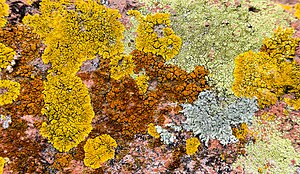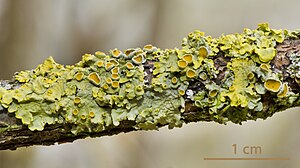Wikipedia:WikiProject Fungi/Lichen task force/Article template
| Main page | Talk | Article alerts | Assessment | Article template | Showcase | Resources | Popular pages | Newsletters | Collaboration | To do |
The following are recommendations for what should be included in the project's genus and species articles:
Short description
[edit]- Either "Species of lichen" or "Genus of lichen", as appropriate.
Taxonomy
[edit]- Who circumscribed [GENUS ARTICLES ONLY] or described it, and when?
- What is the type species? [GENUS ARTICLES ONLY]
- How many species are assigned to the genus? Do disagreements exist? If so, why? [GENUS ARTICLES ONLY]
- Closest relatives (if known)
- Any evolutionary history known? Fossils, etc.?
- What does the scientific name mean? Who does it honour if it's an honorific? (with appropriate wikilink, if article available)
- Was the species originally described under a different name (a basionym)? Does it has a taxonomic history, in which it was shuffled to different genera? If there are synonyms, are they listed in the taxobox with a citation?
- Is there any molecular phylogenetic work that reveals close genetic relatives or its position in a larger phylogenetic framework?
- Be sure to set up any necessary templates to allow use of the automatic taxobox system in the infobox.
- In articles about little known species, it is useful to mention the type locality in the text. Some publications, especially if they are relatively recent, may include geographic coordinates along with the type locality. In these cases, consider adding this data to a template to produce a map (that the reader can use to zoom in and out) to appear in the "range_map" parameter of the taxobox. Examples: Caloplaca tephromelae, Placomaronea kaernefeltii
Morphology
[edit]- Growth types, size, colour, etc.
- Isidia? Apothecia? Soralia?
- Photobiont
- Microscopic characteristics (e.g. ascospore shape, dimensions, colour, ornamentation, amyloid reaction, etc.; how many spores in ascus; distinguishing characteristics of other microscopic structures)
- Any similar species?
- Chemistry: spot test results and secondary products [FOR GENUS TOO if consistent across genus]
Habitat and distribution
[edit]- Where does it occur in the world?
- On what substrate(s)?
- Common? Rare?
- In association with any other lichen, mosses, liverworts, etc.?
Ecology
[edit]- How do they reproduce?
- Any limiting factors? (i.e. are they restricted to certain soil types? certain genera of trees? susceptible to nitrate pollution? etc.)
- Attacked by any lichenicolous fungi?
- Any other regular threats?
- Protected in any part of their range? (i.e. listed as 'critically endangered', etc.)
Uses
[edit]- Do humans use them for any reason? Are they eaten? Used in medicine? Used for dyes?
- Are there any known animal uses? Does anything eat them? Gather them for nesting material?
List of species
[edit][GENUS ARTICLES ONLY] Include this ONLY if there are fewer than about 100 species. Otherwise, this should be a separate list under the title "List of replace with genus name species". For example, see List of Verrucaria species.
Categories
[edit]These should include:
- Lichen genera or Lichen species, as appropriate
- Taxa described in (append appropriate year, YYYY) [GENUS ARTICLES ONLY]
- Lichen described in (append appropriate year, YYYY) [SPECIES ARTICLES ONLY]
- Appropriate family UNLESS it's 'incerta sedis', in which case appropriate order (or class) instead [GENUS ARTICLES ONLY]
- Taxa described by (if category is available; use first author(s) that published the species epithet, not those who later transferred to a different genus)
Other considerations
[edit]Be sure to include the taxonbar – though if you forget, someone else in the project will undoubtedly add one for you! In articles about monotypic genera, the Q-number of the genus is put in the "from=" parameter of the taxnbar, while the Q-number of its single species is placed in "from2=" parameter. These Q-numbers can (usually) be obtained from Wikidata.
Try to find a photo of the type species to use as the lead picture for GENUS articles.



